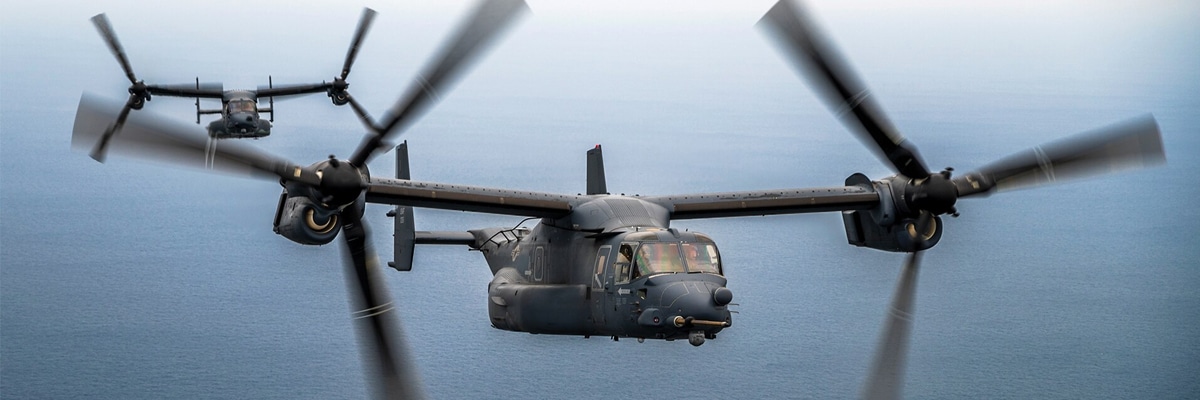Feb. 29 saw news of the signing of a memorandum between Leonardo and Textron Bell to cooperate in the development of a new tiltrotor under the NATO Next Generation Rotorcraft Capability program. This is the return to cooperation between the two companies on a tiltrotor after AgustaWestland at the time took over the entire AW 609 civil tiltrotor program from Bell in 2011, which was the result of a joint venture between Bell and AgustaWestland.
The NATO Next Generation Rotorcraft Capability program involves Italy, France, Germany, Greece, and the Netherlands (while the United Kingdom, Canada, Spain, and the United States are present as observers) to develop a new medium transport aircraft intended to replace more than 900 transport helicopters over the period 2035-2040.
The memorandum between the two companies, the only ones in the world with tiltrotors either operational (Bell) or in the certification phase (Leonardo), in addition to the obvious opportunities for Italian industry (although production of the AW609 tiltrotor takes place in U.S. subsidiaries) is a further sign that for Western armed forces the tiltrotor may impose itself in many of the roles once pertaining to helicopters. This is despite the fact that clouds periodically gather over the operational reliability of the only tiltrotor to date, the Bell V-22 Osprey.
Brief history of the tiltrotor
Convertiplanes, or tiltrotors, are those aircraft capable of switching from a vertical takeoff like that of helicopters to horizontal flight like that of normal airplanes due to the ability to orient the propeller axes. The turboprop engines are placed at the wing tips in nacelles that can rotate from vertical position (for takeoff like a helicopter) to horizontal position (for flight like a normal airplane). Early designs began to appear in the 1940s, with the first experimental models in the 1950s until the Bell XV-15 made its first flight in 1977, becoming the basis for future tiltrotors such as the Bell V-22 Osprey and the AgustaWestland AW609.
The advantage of a tiltrotor over a helicopter is obviously in terms of speed: for example, for the same number of troops carried, a CH-46 Sea Knight helicopter flies at 267 km/h, the V-22 Osprey at 509 km/h.
The V-22 entered service in 2007, and to date more than 400 examples have been produced in service with U.S. and Japanese armed forces. As for the AW609 for which only civilian use is actually planned (the agreement for Bell's divestiture of the program stipulates that no armed variants can be developed, although it does not rule out use with the stars for transport and search and rescue), it is instead being certified for civilian flight authorities.
To these two tiltrotors must be added the Bell V-280 Valor, which is smaller than the Osprey and differs from its larger sibling in having only the propeller and associated gearbox to turn. A tiltrotor that won the U.S. military's Future Vertical Lift program in December 2022. A victory over another unconventional vehicle, the "composite helicopter," compound helicopter (also identified by the obsolete term gyrodine), Sikorsky-Boeing SB-1 Defiant, a vehicle characterized by counter-rotating rotors and a pusher propeller that gives it a speed higher than that of a normal helicopter, but lower (in horizontal flight) than that of a tiltrotor.
The technology of the Sikorsky Defiant and Raider is peculiar because the two counter-rotating rotors have greater stiffness than that of a normal counter-rotating rotor helicopter such as the Russian Kamov. Although the Defiant's is a new technology, many analysts believed that a production model of the Defiant could be more maintenance-efficient than Bell's tiltrotor. As of August 2022, even the sentiment of the Italian Air Force in a hypothetical involvement in the program seemed to lean more toward just the defeated Sikorsky-Boeing SB-1 Defiant that appeared more convincing on the maintenance side (cost and timing).
Sikorsky's composite "competitor"
On the matter of the challenge between the two U.S. rotary-wing champions Bell and Sikorsky, it is worth noting how in February 2024 the U.S. military canceled the Future Attack Reconnaissance Aircraft program for a light attack and reconnaissance helicopter.
A program canceled due to the changing needs of the contemporary battlefield. As evidenced by the situation in the Russian-Ukrainian conflict where Kamov Ka-52 anti-tank helicopters, also considered to be agile and good embedders, suffered major losses. Evidence that has partly reframed the role of the helicopter on the battlefield, delegating many of the functions of a reconnaissance and light assault helicopter such as those of the Future Attack Reconnaissance Aircraft to drones. The Future Attack Reconnaissance Aircraft program pitted two designs against each other: the conventional Bell 360 Invictus helicopter and the Sikorsky Raider X. The latter featured the same rigid counter-rotating rotor technology and pusher propeller as the Defiant.
Several analysts believed that Sikorsky's own composite helicopter, thanks to its speed, could prevail over Bell's conventional helicopter in Future Attack Reconnaissance Aircraft. Also to have the opportunity to continue in the development of a project as well considered promising as Sikorsky's. The cancellation of the Future Attack Reconnaissance Aircraft for the obvious tactical reasons of the contemporary battlefield means that inevitably the development plans for the future of U.S. helicopters all ended up in the Bell tiltrotor basket.
Convertiplanes, lights and some shadows
Despite the 400 vehicles in service and thousands of flight hours accumulated by the V-22 Osprey, shadows are periodically raised about the reliability of the tiltrotor. As was recently the case with all V-22s grounded for three months after a fatal accident to a Marine vehicle in Japan.
It should be immediately reiterated that the V-22 Osprey statistics in hand can be considered safer than the average helicopter. But being a unique craft, besides the inevitable delays in coming online, its accidents still make more headlines than others (for example, the National Guard temporarily halted flights of AH-64 Apaches following two accidents in recent weeks).
But on this occasion, the three-month grounding of V-22 Ospreys (there had been another in the past for problems with rotary engine nacelle clutches) has begun to disrupt the U.S. military's own supply chain (even President Biden's domestic helicopter flights with a dozen MV-22Bs in use to transport escort personnel). The Osprey role has been redistributed to the other available transport helicopters, saturating the maintenance supply chain.
Specialized maintenance, which remains a key and critical area: a shortage of civilian-skilled aircraft mechanics has also emerged in the United States in recent months, and Pentagon recruitment targets are also well below projections. And there has been no shortage of isolated reports of technician errors during routine maintenance, such as an F-35 engine destroyed by a tool left behind by a mechanic. Complex assets require skilled and experienced technicians.
Adding to the general problem of technical downtime for Ospreys was another negative note for the variant that is supplied to the U.S. Navy and intended for use on aircraft carriers as a transport. The new CMV-22B Osprey goes into the light transport role, replacing the twin-engine turboprop C-2 Greyhound. A Pentagon report called this variant of the Osprey totally unsuitable for operational use!
Strong claim but one that has nothing to do with the technology of a tilt-engine tiltrotor tiltrotor. At issue is the Osprey's anti-icing system, which, to simplify, by the nature of the aircraft is closer to that of a helicopter than to that of a transport aircraft, and therefore has shown some limitations in use in adverse weather conditions.
The affair of state aid to the AW609
On the recent history of tiltrotors it is also worth mentioning an exquisitely political issue involving the European Commission and the AW609. Even before the then Agusta Westland completely took over the project from Bell, limiting its possible military uses, the company had received government funds from Italy for a possible variant with stars. Although the AW609 is on the European and international market an absolutely unique vehicle, in 2009 the European Commission had found that the one to the AW609 was a "state aid" undermining competition, forcing in early 2011 the company to return those funds.
A secondary affair, but one that is worth recalling today when the European Commission becomes the interpreter of a new willingness to engage the military, both with the unbundling of defense spending from the budgetary constraints of the Stability Pact and with instruments that move toward a centralized and vertically oriented vision on the part of the Commission, with the possible definition of an ad hoc commissioner.
An issue in which committee chairwoman von der Leyen also claimed a parallel with the management of the Covid emergency and the centralization of contracts with the pharmaceutical industry at the European level.
Defense is a complex issue in which the procurement of appropriate systems must go hand in hand with the rest of the supply chain: research, training and maintenance. If the idea of Von Der Leyen and the European Commission is simply to widen the purse strings and favor European industry certainly the goal of 2 percent of GDP can easily be achieved. But likewise if you forget the entire industrial and military supply chain as a whole, also made up of maintenance and training you risk doing a disservice to the military.
It is worth remembering that before becoming chairwoman of the European Commission, Von Der Leyen was defense minister in Angela Merkel's government from 2013 to 2019. A period in which there was no shortage of news of events bordering on the grotesque regarding the German armed forces: from withdrawal from an international exercise in 2016 because soldiers had run out of overtime, problems with G36 assault rifles, and delays and setbacks in bringing the new F125 frigates into service.
A supply chain that is also made up of set-up costs, training operation and maintenance costs (see also the inglorious affair of the Eurocopter NH-90s assembled in Australia and decommissioned after a few years of service due to poor reliability and high operating costs). No use taking the best on the market and then not having the budget to enable training and ensure maintenance. Or worse, as between the lines is beginning to emerge as the performance of some NATO systems on the Ukrainian battlefield, to have weapon systems that are perfect for exercises but unsuitable for a prolonged use operational environment where maintenance cannot always be carried out as per the operation and maintenance booklet, or where repairs can only be carried out by super-skilled personnel.
Today we live in the grand illusion that thanks to simulators it takes very little to make a boy a drone or tank pilot. But in order to become a technician capable of putting them back into operation, there are still no simulators or AIs that hold. And in a Europe that is losing its civilian industrial supply chain, the risk is that in the event of mobilization, Europe's human capital may no longer have the necessary skills to restart crawlers, aircraft, helicopters, tiltrotors, and the like.
That is, as in the adage attributed to General Omar Bradley, "Dilettantes talk strategy, professionals talk logistics," without a well-distributed chain of skills and capabilities, no centralized European commission plan will hold.
Foto di copertina: – Opera propria CC BY-SA 4.0
An essayist and popularizer, his publications include "Alessandro Blasetti. The forgotten father of Italian cinema" (Idrovolante, 2023). And with Emanuele Mastrangelo "Wikipedia. The Free Encyclopedia and the Hegemony of Information" (Bietti, 2013) and "Iconoclasm. The contagious insanity of the cancel culture that is destroying our history" (Eclectica, 2020).









Scrivi un commento